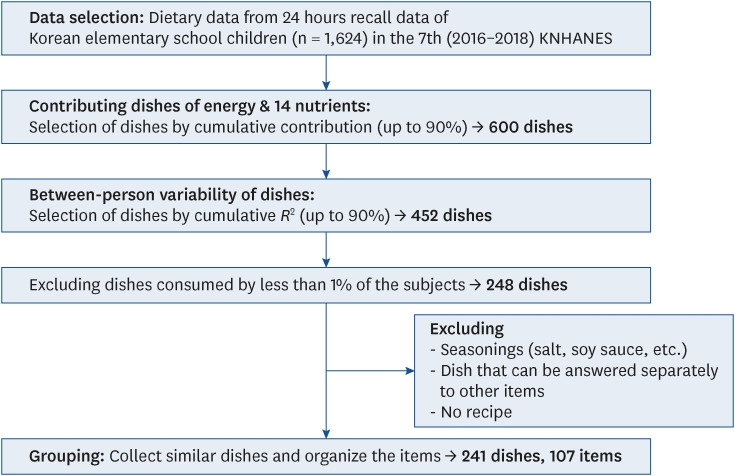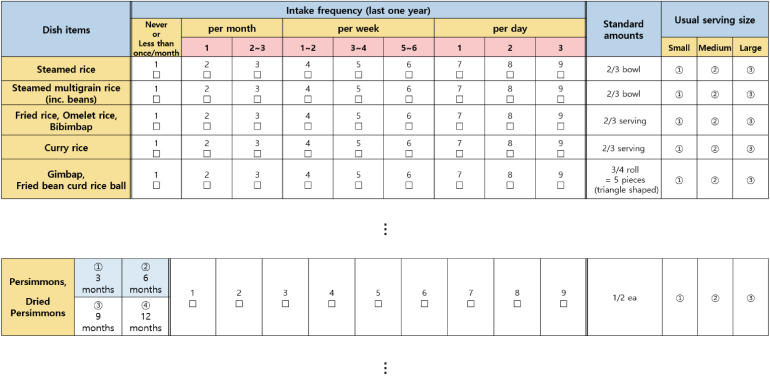Nutr Res Pract.
2023 Aug;17(4):747-761. 10.4162/nrp.2023.17.4.747.
Development of a semi-quantitative food frequency questionnaire for dietary intake of elementary school children: data from the Seventh Korea National Health and Nutrition Examination Survey
- Affiliations
-
- 1Department of Nutritional Science and Food Management, Graduate Program in System Health Science and Engineering, College of Medicine, Ewha Womans University, Seoul 03760, Korea
- 2Department of Environmental Medicine, College of Medicine, Ewha Womans University, Seoul 03760, Korea
- 3Graduate Program in System Health Science and Engineering, Ewha Medical Research Institute, College of Medicine, Ewha Womans University, Seoul 03760, Korea
- 4Institute of Ewha-SCL for Environmental Health (IESEH), College of Medicine, Ewha Womans University, Seoul 03760, Korea
- 5Department of Food and Nutrition, Wonkwang University, Iksan 54538, Korea
- KMID: 2545189
- DOI: http://doi.org/10.4162/nrp.2023.17.4.747
Abstract
- BACKGROUND/OBJECTIVES
In Korea, studies of diet in elementary school children are hindered by the need for a comprehensive dietary assessment tool. Thus, the aim of this study was to develop a semi-quantitative food frequency questionnaire (FFQ) for Korean elementary school children.
SUBJECTS/METHODS
The 24-h recall data for 1,624 subjects aged 6−11 yrs from the seventh Korea National Health and Nutrition Examination Survey were used to extract the items included in the questionnaire. The FFQ items were developed by selecting major dishes based on the results of nutritional contribution and between-person variability for energy and 14 nutrients (carbohydrate, protein, fat, crude fiber, calcium, phosphorous, iron, sodium, potassium, vitamin A, thiamin, riboflavin, niacin, and vitamin C). We selected the major dishes with over 90% of the total contribution to each nutrient and with over 90% of the accumulated R 2 for each nutrient. Among the 452 dishes, we selected 248 dishes contributing more than 1% of the total consumption.
RESULTS
Finally, the FFQ included 107 items combined from 248 dishes based on nutrient profile and recipe. The FFQ items accounted for an average of 88.6% of the energy, 14 nutrient intakes, and 91.4% of the between-person variability. Quantities of dietary intake were assessed by 9 categories of frequency and 3 categories of portion size. Percentages of coverage for energy, protein, fat, carbohydrate, and calcium were 90.2%, 87.8%, 89.9%, 90.8%, and 88.7%, respectively.
CONCLUSIONS
We developed a dish-based, semi-quantitative FFQ comprising 107 items for Korean elementary school children aged 6 to 11. Further studies are needed to evaluate the reproducibility and validity of this FFQ for elementary school children.
Figure
Reference
-
1. Oh SM, Yu YL, Choi HI, Kim KW. Implementation and evaluation of nutrition education programs focusing on increasing vegetables, fruits and dairy foods consumption for preschool children. Korean J Community Nutr. 2012; 17:517–529.
Article2. Benton D. The influence of dietary status on the cognitive performance of children. Mol Nutr Food Res. 2010; 54:457–470. PMID: 20077417.
Article3. Kim JY, Kang SW. Relationships between dietary intake and cognitive function in healthy Korean children and adolescents. J Lifestyle Med. 2017; 7:10–17. PMID: 28261556.
Article4. Eicher-Miller HA, Zhao Y. Evidence for the age-specific relationship of food insecurity and key dietary outcomes among US children and adolescents. Nutr Res Rev. 2018; 31:98–113. PMID: 29318982.
Article5. Lee JS, Hwang JY, Kwon S, Chung HR, Kwak TK, Kang MH, Choi YS, Kim HY. Development of nutrition quotient for elementary school children to evaluate dietary quality and eating behaviors. J Nutr Health. 2020; 53:629–647.
Article6. Hörnell A, Lagström H, Lande B, Thorsdottir I. Protein intake from 0 to 18 years of age and its relation to health: a systematic literature review for the 5th Nordic Nutrition Recommendations. Food Nutr Res. 2013; 57:21083.
Article7. Suri S, Kumar D, Das R. Dietary deficiency of vitamin A among rural children: a community-based survey using a food-frequency questionnaire. Natl Med J India. 2017; 30:61–64. PMID: 28816210.8. Ayeneh Pour A, Moradinazar M, Samadi M, Hamzeh B, Najafi F, Karimi S, Faraji F, Darbandi M, Pasdar Y. Association of Dietary Inflammatory Index with cardiovascular disease in Kurdish adults: results of a prospective study on Ravansar non-communicable diseases. BMC Cardiovasc Disord. 2020; 20:434. PMID: 33028205.
Article9. Räisänen L, Lommi S, Engberg E, Kolho KL, Viljakainen H. Central obesity in school-aged children increases the likelihood of developing paediatric autoimmune diseases. Pediatr Obes. 2022; 17:e12857. PMID: 34608761.
Article10. Shin C, Lim Y, Lim H, Ahn TB. Plasma short-chain fatty acids in patients with Parkinson’s disease. Mov Disord. 2020; 35:1021–1027. PMID: 32154946.
Article11. Wrobleski MM, Parker EA, Hurley KM, Oberlander S, Merry BC, Black MM. Comparison of the HEI and HEI-2010 diet quality measures in association with chronic disease risk among low-income, African American urban youth in Baltimore, Maryland. J Am Coll Nutr. 2018; 37:201–208. PMID: 29313747.
Article12. Hui WF, Betoko A, Savant JD, Abraham AG, Greenbaum LA, Warady B, Moxey-Mims MM, Furth SL. Assessment of dietary intake of children with chronic kidney disease. Pediatr Nephrol. 2017; 32:485–494. PMID: 27687620.
Article13. Cade J, Thompson R, Burley V, Warm D. Development, validation and utilisation of food-frequency questionnaires - a review. Public Health Nutr. 2002; 5:567–587. PMID: 12186666.
Article14. Yum J, Lee S. Development and evaluation of a dish-based semiquantitative food frequency questionnaire for Korean adolescents. Nutr Res Pract. 2016; 10:433–441. PMID: 27478551.
Article15. Yun SH, Shim JS, Kweon S, Oh K. Development of a food frequency questionnaire for the Korea National Health and Nutrition Examination Survey: data from the fourth Korea National Health and Nutrition Examination Survey (KNHANES IV). Korean J Nut. 2013; 46:186–196.
Article16. Sakamaki R, Amamoto R, Mochida Y, Shinfuku N, Toyama K. A comparative study of food habits and body shape perception of university students in Japan and Korea. Nutr J. 2005; 4:31. PMID: 16255785.
Article17. Lee SK, Sobal J, Frongillo EA Jr. Acculturation and dietary practices among Korean Americans. J Am Diet Assoc. 1999; 99:1084–1089. PMID: 10491677.
Article18. Park SY, Paik HY, Skinner JD, Spindler AA, Park HR. Nutrient intake of Korean-American, Korean, and American adolescents. J Am Diet Assoc. 2004; 104:242–245. PMID: 14760574.
Article19. Kim HY, Kwon S, Lee JS, Choi YS, Chung HR, Kwak TK, Park J, Kang MH. Development of a Nutrition Quotient (NQ) equation modeling for children and the evaluation of its construct validity. Korean J Nut. 2012; 45:390–399.
Article20. Del Gobbo LC, Khatibzadeh S, Imamura F, Micha R, Shi P, Smith M, Myers SS, Mozaffarian D. Assessing global dietary habits: a comparison of national estimates from the FAO and the Global Dietary Database. Am J Clin Nutr. 2015; 101:1038–1046. PMID: 25788002.
Article21. Deierlein AL, Bihuniak JD, Nagi E, Litvak J, Victoria C, Braune T, Weiss R, Parekh N. Development of a technology-assisted food frequency questionnaire for elementary and middle school children: findings from a pilot study. Nutrients. 2019; 11:1103. PMID: 31108961.
Article22. Hinnig PF, Mariath AB, Freaza SR, Gambardella AM, Bergamaschi DP. Development of a food frequency questionnaire for children from 7 to 10 years old. Rev Bras Epidemiol. 2014; 17:479–494. PMID: 24918418.
Article23. Kobayashi T, Tanaka S, Toji C, Shinohara H, Kamimura M, Okamoto N, Imai S, Fukui M, Date C. Development of a food frequency questionnaire to estimate habitual dietary intake in Japanese children. Nutr J. 2010; 9:17. PMID: 20380735.
Article24. Miyawaki A, Lee JS, Kobayashi Y. Impact of the school lunch program on overweight and obesity among junior high school students: a nationwide study in Japan. J Public Health (Oxf). 2019; 41:362–370. PMID: 29873776.
Article25. Condon EM, Crepinsek MK, Fox MK. School meals: types of foods offered to and consumed by children at lunch and breakfast. J Am Diet Assoc. 2009; 109:S67–S78. PMID: 19166674.
Article26. Lee SM. Development and evaluation of a brief fruit and vegetable food frequency questionnaire for higher-grade elementary school children. J East Asian Soc Diet Life. 2008; 18:675–683.27. Ciotti M, Ciccozzi M, Terrinoni A, Jiang WC, Wang CB, Bernardini S. The COVID-19 pandemic. Crit Rev Clin Lab Sci. 2020; 57:365–388. PMID: 32645276.
Article28. Choi J, Park Y, Kim HE, Song J, Lee D, Lee E, Kang H, Lee J, Park J, Lee JW, et al. Daily life changes and life satisfaction among Korean school-aged children in the COVID-19 pandemic. Int J Environ Res Public Health. 2021; 18:3324. PMID: 33807042.
Article29. Rha JY, Lee B, Nam Y, Yoon J. COVID-19 and changes in Korean consumers’ dietary attitudes and behaviors. Nutr Res Pract. 2021; 15:S94–109. PMID: 34909136.
Article30. Cummings SR, Block G, McHenry K, Baron RB. Evaluation of two food frequency methods of measuring dietary calcium intake. Am J Epidemiol. 1987; 126:796–802. PMID: 3661527.
Article31. Kang M, Shim JE. Development of a food frequency questionnaire for dietary intake of preschool children. Nutr Res Pract. 2020; 14:374–383. PMID: 32765817.
Article32. Wakimoto P, Block G. Dietary intake, dietary patterns, and changes with age: an epidemiological perspective. J Gerontol A Biol Sci Med Sci. 2001; 56(Spec No 2):65–80. PMID: 11730239.
Article33. Jeong K, Kim J, Ahn K, Lee SY, Min TK, Pyun BY, Kim YH, Kim KW, Sohn MH, Kim KE, et al. Age-based causes and clinical characteristics of immediate-type food allergy in Korean children. Allergy Asthma Immunol Res. 2017; 9:423–430. PMID: 28677356.
Article34. Ahn Y, Lee JE, Paik HY, Lee HK, Jo I, Kimm K. Development of a semi-quantitative food frequency questionnaire based on dietary data from the Korea National Health and Nutrition Examination Survey. Nutr Sci. 2003; 6:173–184.35. Kim SH, Kim MS, Lee MS, Park YS, Lee HJ, Kang S, Lee HS, Lee KE, Yang HJ, Kim MJ, et al. Korean diet: characteristics and historical background. J Ethn Foods. 2016; 3:26–31.
Article
- Full Text Links
- Actions
-
Cited
- CITED
-
- Close
- Share
- Similar articles
-
- The Development and Evaluation of a Simple Semi-quantitative Food Frequency Questionnaire to Assess the Dietary Intake of Adults in Large Cities
- Relationships between Nutrient Intake Status and Sugar-containing Food Intake of Elementary School Students in Daegu-Kyungbook Area
- Food Diversity and Nutrient Intake of Elementary School Students in Daegu-Kyungbook Area
- Analysis of the Difference in Nutrients Intake, Dietary Behaviors and Food Intake Frequency of Single- and Non Single-Person Households: The Korea National Health and Nutrition Examination Survey (KNHANES), 2014–2016
- Association of Household Food Security with Dietary Intake: Based on the Third (2005) Korea National Health and Nutrition Examination Survey (KNHANES III)



